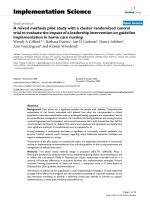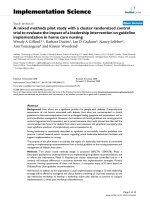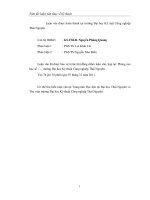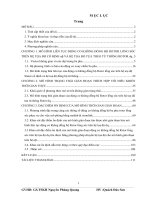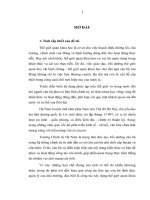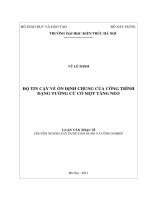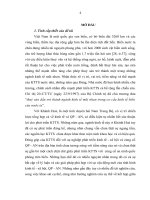(Luận văn thạc sĩ) the impact of perceived leadership styles on organizational commitment
Bạn đang xem bản rút gọn của tài liệu. Xem và tải ngay bản đầy đủ của tài liệu tại đây (2.24 MB, 102 trang )
MINISTRY OF EDUCATION AND TRAINING
UNIVERSITY OF ECONOMICS HO CHI MINH CITY
-----oOo-----
Nguyen Thi Tuy An
THE IMPACT OF PERCEIVED LEADERSHIP STYLES
ON ORGANIZATIONAL COMMITMENT
MASTER OF BUSINESS ADMINISTRATION THESIS
HO CHI MINH City - 2012
MINISTRY OF EDUCATION AND TRAINING
UNIVERSITY OF ECONOMICS HO CHI MINH CITY
-----oOo-----
Nguyen Thi Tuy An
THE IMPACT OF PERCEIVED LEADERSHIP STYLES
ON ORGANIZATIONAL COMMITMENT
Major:
Business Administration
Major code:
60340102
MASTER OF BUSINESS ADMINISTRATION THESIS
SUPERVISOR: ASSOC. PROF. DR. NGUYEN DINH THO
HO CHI MINH City - 2012
1
Contents
Acknowledgement .............................................................................................................................. i
Declaration ......................................................................................................................................... ii
List of tables ...................................................................................................................................... iii
List of figures .................................................................................................................................... iii
Abstract ............................................................................................................................................. iv
CHAPTER I
1.1
INTRODUCTION ............................................................................................ 1
Background ........................................................................................................................ 1
1.1.1
Organizational Commitment significance .................................................................. 1
1.1.2
The importance of Leadership Style .......................................................................... 2
1.1.3
Current factors affect organizations in Ho Chi Minh City ......................................... 3
1.2
Statement of the Problem ................................................................................................... 4
1.2.1
Employees’ commitment ........................................................................................... 4
1.2.2
Leadership .................................................................................................................. 5
1.3
Research objective and its significance.............................................................................. 6
1.3.1
Research objective ..................................................................................................... 6
1.3.2
Research significance ................................................................................................. 7
1.4
Extent and methodology of the study................................................................................. 7
1.4.1
Extent of the study ..................................................................................................... 7
1.4.2
Research methods....................................................................................................... 7
1.5
Some concepts related to the research................................................................................ 8
1.5.1
Organizational Commitment ...................................................................................... 8
1.5.2
Leadership and Leadership Style ............................................................................... 9
1.6
Organization of the Remainder of the Study .................................................................... 10
CHAPTER II
LITERATURE REVIEW ............................................................................... 12
2.1
Introduction on Organizational Commitment .................................................................. 12
2.2
Introduction on Leadership Style ..................................................................................... 14
2.3
Concept of each element of Organizational Commitment and Leadership Style model .. 17
2.3.1
Affective commitment ............................................................................................. 17
2.3.2
Continuance commitment ........................................................................................ 17
2.3.3
Normative commitment ........................................................................................... 18
2
2.3.4
Task Orientation ....................................................................................................... 18
2.3.5
Relation Orientation ................................................................................................. 18
2.4
Development of Research Hypotheses............................................................................. 19
2.4.1
Task Orientation and Organizational Commitment ................................................. 19
2.4.2
Relation Orientation and Organizational Commitment ............................................ 19
2.5
Research Model................................................................................................................ 20
CHAPTER III
3.1
METHODOLOGY ........................................................................................... 23
Description of Instrumentation ........................................................................................ 23
3.1.1
Organizational Commitment Questionnaire............................................................. 23
3.1.2
Leadership Style Questionnaire ............................................................................... 25
3.2
Independent and Dependent Variables ............................................................................. 26
3.3
Sample and Analysis Procedures ..................................................................................... 27
3.3.1
Sample ...................................................................................................................... 28
3.3.2
Analysis Procedures ................................................................................................. 28
CHAPTER IV
ANALYSIS AND FINDINGS ......................................................................... 31
4.1
Sample description ........................................................................................................... 31
4.2
Reliability of Scales ......................................................................................................... 32
4.2.1
Organizational Commitment .................................................................................... 32
4.2.2
Leadership Style ....................................................................................................... 33
4.3
Exploratory Factor Analysis ............................................................................................. 34
4.4
Descriptive Statistics for Leadership Style and Organizational Commitment Score ....... 37
4.4.1
Organizational Commitment Score .......................................................................... 37
4.4.2
Leadership Style Score ............................................................................................. 37
4.5
Relationship between Leadership Styles and Organizational Commitment .................... 38
4.5.1
Regression of Relation Orientation, Task Orientation and Affective Commitment 40
4.5.2
Regression of Relation Orientation, Task Orientation and Continuance Commitment
45
4.5.3
Regression of Relation Orientation, Task Orientation and Normative Commitment
48
3
CHAPTER V
SUMMARY, CONCLUSIONS AND RECOMMENDATIONS ..................... 51
5.1
Research Hypotheses ....................................................................................................... 51
5.2
Summary of Findings ....................................................................................................... 51
5.3
Conclusions ...................................................................................................................... 52
5.3.1
Organizational Commitment and Leadership Style Scale ........................................ 52
5.3.2
Organizational Commitment and Leadership Style Score ....................................... 53
5.3.3
Organizational Commitment and Leadership Style Relation ................................... 54
5.4
Managerial Implications................................................................................................... 54
5.4.1
Organizational Commitment .................................................................................... 54
5.4.2
Leadership Styles ..................................................................................................... 55
5.4.3
Leadership Styles and Organizational Commitment ................................................ 57
5.5
Limitations and suggestions ............................................................................................. 57
BIBLIOGRAPHY ............................................................................................................................ 59
APPENDIX 1: LIST OF KEY CONCEPS IN THE STUDY .......................................................... 63
1.
Organizational Commitment ............................................................................................... 63
2.
Leadership and Leadership Style ........................................................................................ 64
a.
Leadership ........................................................................................................................ 64
b.
Leadership Style ............................................................................................................... 65
APPENDIX 2: QUESTIONNAIRE ................................................................................................. 66
1.
English version.................................................................................................................... 66
2.
Vietnamese version ............................................................................................................. 69
APPENDIX 3: CHECKING RELIABILITY OF INSTRUMENTS................................................ 72
1.
Organizational Commitment Scale ..................................................................................... 72
a.
Affective commitment ..................................................................................................... 72
b.
Continuance commitment ................................................................................................ 72
c.
Normative commitment ................................................................................................... 73
d.
Reliability of Organizational Commitment Scale ............................................................ 73
2.
Leadership Style Scale ........................................................................................................ 74
a.
Task Orientation ............................................................................................................... 74
b.
Relation Orientation ......................................................................................................... 75
4
c.
Reliability of Leadership Style Scale ............................................................................... 75
APPENDIX 4: EXPLORATORY FACTOR ANALYSIS ................................................................ 77
APPENDIX 5: REGRESSION ........................................................................................................ 82
1.
Multiple regression for Affective Commitment .................................................................. 82
a.
Assumptions ..................................................................................................................... 82
b.
Result ............................................................................................................................... 84
2.
Multiple regression for Continuance Commitment ............................................................. 85
a.
Assumptions ..................................................................................................................... 85
b.
Result ............................................................................................................................... 88
3.
Multiple regression for Normative Commitment ................................................................ 89
a.
Assumptions ..................................................................................................................... 89
b.
Result ............................................................................................................................... 91
i
Acknowledgement
I would like to thank the following people who helped to make this
research possible:
Respectful lecturers of University of Economics Ho Chi Minh City for
empowering me with considerably useful knowledge during the time I studied
in the University.
Assoc. Prof. Dr. Nguyen Dinh Tho, for supporting and guiding with his
patience and competence throughout my dissertation writing.
Respondents, for giving their precious time in inputting the
questionnaires.
My family, for encouraging me all the time.
Even I have tried my best to complete the thesis, however, human
errors might be found. Therefore, all inputs, ideas, and comments would be
greatly appreciated.
Nguyen Thi Tuy An
Ho Chi Minh, November 2012
ii
Declaration
Student number: 7701080001
I would like to declare that this dissertation, “The impact of perceived
leadership styles on organizational commitment”, was accomplished based on
my recent independent and serious studies and has not been previously, in its
entirety or in part, submitted at any university in order to obtain academic
qualifications, the data was collected in reality, and all used sources were
indicated and acknowledged by means of complete bibliography.
Nguyen Thi Tuy An
iii
List of tables
Table 2. 1 Four periods of the development of Organizational Commitment ..................... 13
Table 2. 2 Different points of Leadership Style Approach .................................................. 16
Table 3. 1 Surveyed items used in the study for independent variables .............................. 26
Table 3. 2 Surveyed items used in the study for dependent variables ................................. 27
Table 4. 1 Demographic data ............................................................................................... 31
Table 4. 2 Reliability of Organizational Commitment Scale ............................................... 33
Table 4. 3 Reliability of Leadership Style Scale .................................................................. 34
Table 4. 4 Factor Analysis of Organizational Commitment and Leadership Style .............. 36
Table 4. 5 Organizational Commitment Descriptive Statistics ............................................ 37
Table 4. 6 Leadership Style Descriptive Statistics ............................................................... 37
Table 4. 7 Correlation between Leadership Styles and Organizational Commitment ......... 39
Table 4. 8 Overall relationship between Leadership Styles and Affective Commitment 1 . 43
Table 4. 9 Overall relationship between Leadership Styles and Affective Commitment 2 . 43
Table 4. 10 Relationship of each Leadership Style and Affective Commitment ................. 44
Table 4. 11 Overall Relationship between Leadership Styles and Continuance Commitment
1 ........................................................................................................................................... 46
Table 4. 12 Overall Relationship between Leadership Styles and Continuance Commitment
2 ........................................................................................................................................... 46
Table 4. 13 Relationship of each Leadership Style and Continuance Commitment ............ 47
Table 4. 14 Overall Relationship between Leadership Styles and Normative Commitment 1
............................................................................................................................................. 48
Table 4. 15 Overall Relationship between Leadership Styles and Normative Commitment 2
............................................................................................................................................. 49
Table 4. 16 Relationship of each Leadership Style and Normative Commitment ............... 49
List of figures
Figure 2. 1 Research Model .............................................................................................. 22
Figure 3. 1 Research Process ............................................................................................ 30
Figure 5. 1 Research Findings .......................................................................................... 52
iv
Abstract
The purpose of research was to explore the impact of perceived leadership
styles on organizational commitment.
The population was the employees working in Ho Chi Minh City.
The used methods were qualitative and quantitative one based on two
instruments of Organizational Commitment Questionnaire (Meyer and Allen, 2004)
and Leadership Style Questionnaire (Northouse, 2010).
From this study, we could find that:
The organizational commitment in Ho Chi Minh City was at moderate
level.
The leadership style used by most leaders in Ho Chi Minh City was at
moderate range of task and relation orientation.
There
was
a
statistically
significant
relationship
between
organizational commitment of the employees and their perception of
supervisors’ leadership styles.
1
CHAPTER I
INTRODUCTION
This chapter will present the background of Organizational Commitment and
Leadership Style in Ho Chi Minh City recently. Problem statement, objective,
significance, extent and methods of the research and some key concepts used in the
study will also be presented.
1.1
Background
1.1.1
Organizational Commitment significance
Organizational commitment is important in human resource management and
organizational achievement because of the following reasons:
Firstly, organizational commitment affects the employees’ intention to stay or
leave and cost of maintaining workforce of organizations. By improving
organizational commitment, an organization could have “an 87% reduction in
employees’ probability of departure (Corporate Leadership Council, 2004,
p.4)” and avoid the cost “estimated 100% to 150% of the departing worker’s
annual salary (Mayfield and Mayfield, 2002, p. 89).”
Secondly, if the organizational commitment is low, along with the possibility of
high turnover rate and huge expense as above mentioned, organizations could
be at risk of leaking customers’ or technology’s information which is extremely
critical in current competitive environment.
Last but not least, committed employees provide high quality during their
performance. Corporate Leadership Council (2004, p.4) found that “By
increasing employees’ engagement levels, organizations can expect an increase
2
in performance of up to 20 percentile points.”
In brief, organizational commitment could be considered as a predictor of
turnover, replacement cost, information security and job performance of an
organization.
1.1.2
The importance of Leadership Style
The first role of a leader is to lead and the leadership style does matter since it
influences her/his organization in every stage of its development. For example,
Pham Thi Dieu Hien, the leader of BiAnFishco, bought two Rolls Royce motor cars
just in the purpose of building the brand name for her company and the current
failure of this organization was attached with her style. Mai Kieu Lien, the Chief
Executive Officer of Vinamilk, is another example. Under her leading way, her
group becomes one of Vietnam's most profitable and respected brand-name across
Asia and as a result, Forbes listed her in the top 50 Asia Power Businesswomen
(Forbes, 2012).
Undeniably, every organization needs a leader and Inyang (2009, p.68) stated
that “Leadership is the most important single factor in determining business
success.” Being reflected in every single activity of that organization, the leadership
style hence goes along with its reputation:
Through her/his proper leading style, leader helps the organization to maximize
efficiency and to achieve setting goals.
Under her/his wise leading style, leader initiates structure for working,
motivates employees, provides instructions, creates confidence, and builds
morale and working environment.
3
1.1.3
Current factors affect organizations in Ho Chi Minh City
Ho Chi Minh City is the largest economic center of Vietnam. Its Provincial
Competitiveness Index (PCI) is ranked 20 (PCI, 2012), meaning it has acceptable
indicator of entry cost, land access and tenure, transparency, time costs, informal
charge, pro-activity, business support services, labor training, and legal institutions.
With such index, it is easy to explain the large number of enterprises and employees
operating in this city. However, enterprises in Ho Chi city do not easily run today
due to recent challenges listed as following:
Since 2011, under the affect of gloomy global economy and the disadvantages
due to high inflation, bad debts, liquidity shortage, and foreign balance
deficit… enterprises in Ho Chi Minh City have been undergoing an incredibly
tough period. As consequence, until June 2012, nation-widely, there are 23,689
enterprises cease operating (General Statistics Office, 2012). According to Tax
Department (2012, as cited in VCCI, 2012), in Ho Chi Minh City, in the first
two months of 2012, there were more than 3.100 enterprises declaring
bankruptcy.
A survey conducted by Vietnam WVB Financial Intelligence Services showed
that generally, Business Confidence Index (BCI) sharply dropped from 123
points in the 3rd quarter in 2011 to 116 points in the first quarter of 2012
(Saigon Times, 2012). This survey also revealed that mainly, enterprises faced
the extreme difficulty in gaining access to capital. In order to contend, the
survivals are encouraged to cut cost, restructure and or join the wave of
mergers and acquisitions.
4
The Government has been processing wider economy reform. It also maintains
strict fiscal and monetary policies to control inflation. As result of the
Governmental effort in administering macroeconomics, in last March,
Bloomberg listed Vietnam in top 50 best countries for business ranking
(Bloomberg, 2012). Also, in 06 June 2012, “Standard & Poor's revised the
outlook on Vietnam to stable from negative and affirmed the 'BB-' long-term
and 'B' short-term sovereign credit ratings for our country (Government Web
Portal, 2012).”
1.2
1.2.1
Statement of the Problem
Employees’ commitment
Through many years of struggling against employees’ jumping, organizations
have well acknowledged the risk of shifting employees and role of employees’
commitment in current competitive environment. In this regard, they start paying
attention into their salary scheme as well as their benefit and training policies.
Gradually, employee’s engagement programs have become priorities in Human
Resource activities of some organizations and the concept of “employees as assets”
has been formed.
However, regardless of such great effort of organizations, according to the
survey of Towers Watson, in Vietnam, the employees’ intention to stay with
organization was just at low level of 54%. This meant there was great potential for
employees to leave their organizations (Ruge, 2011) and they often resigned after
every Lunar New Year. Even this tendency has decreased in 2012 and the turnover
ratio is forecasted to reduce this year, still “the fact that employee turnover always
5
stays at a two-digit level has sparked great concern for managers (Nghia, 2012).”
Meanwhile, based on the information of Center of Forecasting Manpower Needs
and Labor Market Information Ho Chi Minh City, in the end of this year,
organizations in Ho Chi Minh City will need the labor market to provide 135.000
employees more (Thuy, 2012). In that event, surely, organizational commitment will
continue to remain as a difficult problem for enterprises to solve.
1.2.2
Leadership
The year of 2011 has seen the biggest human resource change at the top levels
of Vietnamese economy. In FPT, Truong Dinh Anh replaced Nguyen Thanh Nam;
in Bitexco, Vu Quang Bao was replaced by In Suk Ko (Thanh, 2011). Abnormally,
in banking sector, many banks appointed new leaders. For example, Western Banks
has just replaced Dang Duc Toan, LienVietPostBank has just accepted the resign
letter of Le Hong Phong (Khanh, 2012), Vu Tu has been no longer with TienPhong
Bank, Dang Quang Minh has been temporarily holding Chief Executive Officer
position of ABBank, Phan Huy Khang moved from Southern Bank to Sacombank.
Even, some organizations have hired foreign Chief Executive Officers, for example
Maritime Bank with Atul Malik, Mekong Bank with Lau Boon Tuan, Techcombank
with Simon Morris (Business Times, 2012). Explaining for such replacement,
resignation and foreign element, Hoang (2012) cited by Khanh (2012) suggested
using the term “risk management.” Leaders’ transition means there would be a
significant change in style which might threaten the ability to stay competitive of
organizations.
From part 1.1.1 and 1.1.2, both leadership style and employee commitment are
very important for the performance achievement of any organization. Whereas,
6
under the environment mentioned in part 1.1.3, strategic changes are necessary for
every enterprise existing and developing. To take advantage of opportunities and
compete successfully through hard moment, enterprises need both effective leaders
and professional employees. However, based on the point 1.2.1 and 1.2.2, currently,
there are two problems: the low level of employees’ commitment and replacement
or resignation of respected leaders. Certainly, these facts affect organizations
because through leadership style transition, the employees can experience the
confusion of whether to leave or stay with the organizations or their commitment
becomes an unknown variable. Moreover, when a new leader comes, whether
her/his style is accepted by the existing employees is unanswered question.
Meantime, the quality of leadership in an organization would be reflected through
employee commitment (Stum, 1998) and “employee commitment is one of the most
important measures of leaders success” (Mayfield and Mayfield, 2002, p. 89), the
employee commitment and leadership styles and their relation then should be
discussed.
1.3
1.3.1
Research objective and its significance
Research objective
As previously proposed, in current environment, to overcome the crisis and
remain profitable, enterprises require their leaders to perform more effectively and
professional employees to commit more deeply. Considering that there is great
potential that leadership styles play key role in building and retaining necessary
organizational commitment, the main objective of this research is to examine the
impact of perceived leadership styles on organizational commitment in
organizations in Ho Chi Minh City.
7
1.3.2
Research significance
It is obvious that there are not many researches processed on the relation
between Leadership Styles and Organizational Commitment and the findings on this
relation are not consistent, so a great niche is still left for exploring and re-assessing
this interesting topic. Basically, this study will help:
To measure employees’ commitment
To understand the leadership styles perceived by employees
To explore the extent to which leadership styles can affect organizational
commitment.
1.4
1.4.1
Extent and methodology of the study
Extent of the study
For Organizational Commitment, the study would focus on Affective,
Continuance and Normative component. For Leadership Style, two dimensions of
Task and Relation Orientation would be analyzed. The targets of the study are the
employees who work in Ho Chi Minh City.
1.4.2
Research methods
Two steps are processed during this study:
Qualitative method
Since the original questionnaire is in English, the translation is necessary for
data collection. This first step is processed by carrying out deep interviews with 5
employees to check whether the Vietnamese version is understandable and matched
with the original one.
8
Quantitative method
Based on the first step, after adjusted, the final version of questionnaire
would be delivered for dada collecting. When this is done, Quantitative study - the
second step would be implemented. Through this step, the reliability and validity of
used instruments would be checked and deep analysis would be carried out.
1.5
Some concepts related to the research
1.5.1
Organizational Commitment
We are witnessing the time when a contract seems no longer to retain
employees, but the state of being a part of the organization. Thus a bundle of studies
on Organizational Commitment has been taken, revealing that the degree of
attachment of that employee with her/his organization has reciprocal relation with
her/his intention to leave. The definitions of various authors were summarized in
Appendix 1. Some definitions could be listed as following:
Organizational commitment is the degree to which you identify with the
organization, relative to other factors that affect you at work, such as work itself or
factors outside the organization that compete with it for your commitment and
identification (Tosi and Mero, 2003, p. 47).
Organizational commitment is about identification with the goals and values of
the organization, a desire to belong to the organization and a willingness to display
effort on its behalf (Armstrong and Brown, 2006, p.54).
Organizational commitment is defined as the relative strength of an employee's
identification with the company, hence increasing the desire to maintain membership
(Smith et al., 2010, p. 31).
9
In short, Organizational Commitment is the relative strength of an employee’s
identification with, involvement in, linkage with, loyalty to, attachment with an
organization. With high degree of Organization Commitment, the employee
believes in the goal and value of her/his organization. She/he is also willing to make
effort for the organization and remains the desire being one of its members.
1.5.2
Leadership and Leadership Style
Leadership
In the field of Organizational Behavior and Management, Leadership was an
important subject and popular topic. There were many definitions and concepts for
Leadership and we could summarize some of famous authors into Appendix 1 and
several of them are as below:
Leadership is the “centralization of effort in one person as an expression of the
power of all (Blackmar, 1911, p.626).”
Leadership is “an intrinsic part of management. It is the manner in which
managers conduct themselves in their role in order to obtain the best performance
from the people they are managing (Walker, 2007, p.213).”
In brief, Leadership is the status of someone, at a special high position in
compared with other group members. Through her/his vision, influence, power,
consideration, direction and judgment, she/he maintains the competitive
environment for other members to achieve the group’s goal on performance.
10
Leadership Style
In the word “leader” we could find the implication of “going in front” and
“showing the way.” So a leader should be the one with courage, taking the first step
and guiding others, while his “style” is his way achieving these through thinking,
reacting, relating others. Few of academic definitions on Leadership Style were listed
in Appendix 1. Dominantly, we have:
Leadership style is the manner and approach of providing direction,
implementing plans, and motivating people (Clark, 1997).
Leadership Style can be described by how the leader makes decisions, handles
information, builds relationship with other people, and motivates and controls
subordinates (Burton and Obel, 1998, p.92).
Leadership Style is the way in which a leader relates to staff and colleagues
(Pelote and Route, 2008, p. 298).
In sum, Leadership Style is one’s manner /ability to act in a manner/pattern/
approach/way to “lead” others. “Lead” means guiding, controlling, motivating,
making decisions, building relationships…, and most important, inspiring others.
1.6
Organization of the Remainder of the Study
The reminder of the study would consist four parts.
Chapter 2 Literature Review
This chapter will review literature on Leadership Style, Organizational
Commitment and development of research hypotheses and model.
Chapter 3 Methodology
11
This chapter will detail the research design and methodology of this study.
Chapter 4 Findings and Analysis
This chapter will present the data collected.
Chapter 5 Summary, Conclusions and Recommendations
This chapter will display the findings, conclusions and recommendations of this
study.
The Bibliography lists works cited in the study.
The Appendixes contains the Questionnaire and results of the study.
12
CHAPTER II
LITERATURE REVIEW
The scope of this Chapter is to provide an overview of the background based
on which the thesis is built. Under the scope of this study, the variables of
organizational commitment including Affective, Continuance, and Normative
Commitment and the variables of leadership style including Task and Relation
Orientation would be focused. In detail, five topics included in this Chapter are the
introduction on Organizational Commitment and Leadership Style, concept of each
element in Organizational Commitment and Leadership Style model, development
of research hypotheses and research model.
2.1
Introduction on Organizational Commitment
In history, mainly, there were two theoretical approaches on Organizational
Commitment:
Attitude approach focusing on tendency or orientation of the employees.
Behavior approach focusing on action or reaction of the employees (Amernic
and Aranya, 1983)
However, under the work of Meyer and Allen (1984), these two approaches
have been integrated (Prabhakar and Ram (2011). So when mentioning on the
development of Organizational Commitment, only its period section is taken into
consideration. The most generalized work in such division is Weibo et al’s review
(2009) comprising all stages of its development. Under this paper, till today, the
research on organizational commitment has passed four periods.
From the Table 2.1, we could see that currently, the model proposed by Meyer
13
and
Allen
has
better
content
than
models
in
Side-Bet
and
Middle
Affective-Development Period. Also, in comparing with the models proposed in
New-Development which are not well validated and complex, Three components of
Organizational Commitment of Meyer and Allen is most proper to focus under the
scope of this research.
Table 2.1 Four periods of the development of Organizational Commitment
(WeiBo, et al., 2010)
N# Period
Author
Main content
According to Becker (1960), the commitment exists because the
1
Side-Bet Period
employees have made a side-bet or they have a contractual
relation with the organization. By the time, this investment
Becker
(1960)
accrues and makes it more difficult for the employees to leave
the organization. Although the validity of the theory was
disputed, Becker’s discovery about the relation with turnover
has
still
affected
later
frameworks
on
organizational
commitment.
In this period, Porter et al., start to study the psychological
aspect of organizational commitment. Still based on the
2
Middle Affective-Dependence Period
assumption of Becker's theory about the relation between
commitment and turnover, in their opinion, the employees
commit not only because of contractual relation but more
significantly because of affective influence. They argue that
Porter et al.(1974,
1979)
the commitment is built based on the combination of three
factors: strong acceptance, participation and loyalty. They
developed
a
tool
name
Organizational
Commitment
Questionnaire with satisfied reliability. However, still there
have been some critics on some items dealt with turnover or
performance intention, which means the scale reflects
behavioral intentions than attitudes and that it is hard to classify
three factors including strong acceptance, participation and
loyalty that characterized commitment.
14
N# Period
Author
Main content
O'reilly and Chatman claim that commitment is psychological
attachment. It is built based on three factors of compliance,
3
Multi-Dimension Period
identification and internalization and passes through two
O'Reilly and
processes: shallower and deeper attachment. Even these authors
Chatman (1986)
contributed
to
the
understanding
of
the
antecedents,
consequences and outcomes of commitment, few researchers
followed this theory due to the limitation of its unclear
mechanism.
At first, Meyer and Allen just proposed two components of
Affective and Continuance Commitment. In 1990, they added
Meyer and Allen
(1984, 1990,
1997)
the third component named Normative Commitment into their
theory. They argued that these components could be sensed at
the same time by an employee. They also conducted analyses on
the
antecedents
and
consequences
of
organizational
commitment. By doing this, their theory contributes better
content to the understanding of organizational commitment.
In 2007, Cohen advanced organizational commitment to new
4
New Development
Cohen (2007)
period with his new model to measure it based on new
dimension: time and style of commitment.
However, the
validity of this study would need to be checked.
Somers (2009) studied the influence of the combination of
organizational commitment's components on work results. He
suggests
Somers (2009)
eight
committed,
commitment
affective
profiles
dominant,
including:
continuance
highly
dominant,
normative dominant, AC–CC dominant, AC–NC dominant,
CC–NC dominant and uncommitted. These profiles are hard to
measure and cause the complexity to the model.
2.2 Introduction on Leadership Style
According to Porter-O'Grady and Malloch (2010), we could break down the
development of Leadership into eight major theoretical frames including "Great
15
Man" Theories, Trait Theories, Contingency Theories, Situational Theories,
Behavioral Theories, Participative Theories, and Management Theories (or
Transactional Theories). Among the above frames, Behavioral Theories or
Leadership Style Approach focuses on the leaders’ behaviors or concentrates on
what leaders actually do. Principal assumptions of this approach are: great leaders
could be made, leadership capability could be learned, practiced and adopted over
time, and as a result, leaders become more versatile and effective. Two directions of
this approach are:
Leader behaves based on her/his point of view over employees’ characteristics.
Some authors with this direction include Lewin, Linkert, and Goleman.
Leader behaves based on her/his characteristics. Researches verifying this
direction were processed by Ohio State University, University of Michigan, and
Blake and Mouton. (Northouse, 2012)
Under the scope of this study, an analysis on the second direction is processed
because it is most suitable with the research’s objective emphasizing on leadership
styles perceived by employees.
Generally, under Ohio State Studies, the University of Michigan Studies, and
Blake and Mouton Grid, Leadership Style includes two kinds: Task and Relation
Orientation, while the differences of these studies are summarized as Table 2.2.
In summary, the points of view of the Ohio State Studies are most supported.
Because there is a strong agreement on the opinion that these two dimensions are
“two different continua (Northouse, 2010, p.71).” In fact, at the same time, we
could found a leader with both Task and Relation Oriented characteristics with
